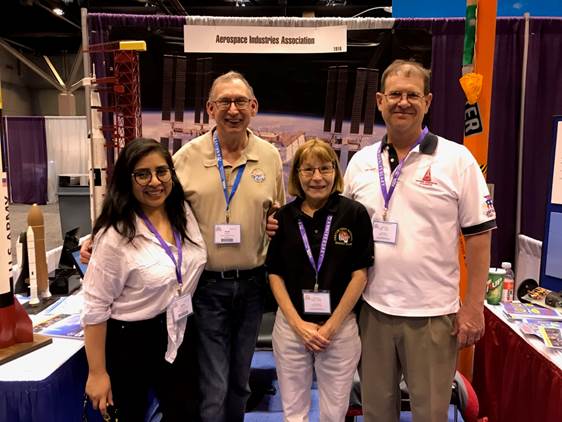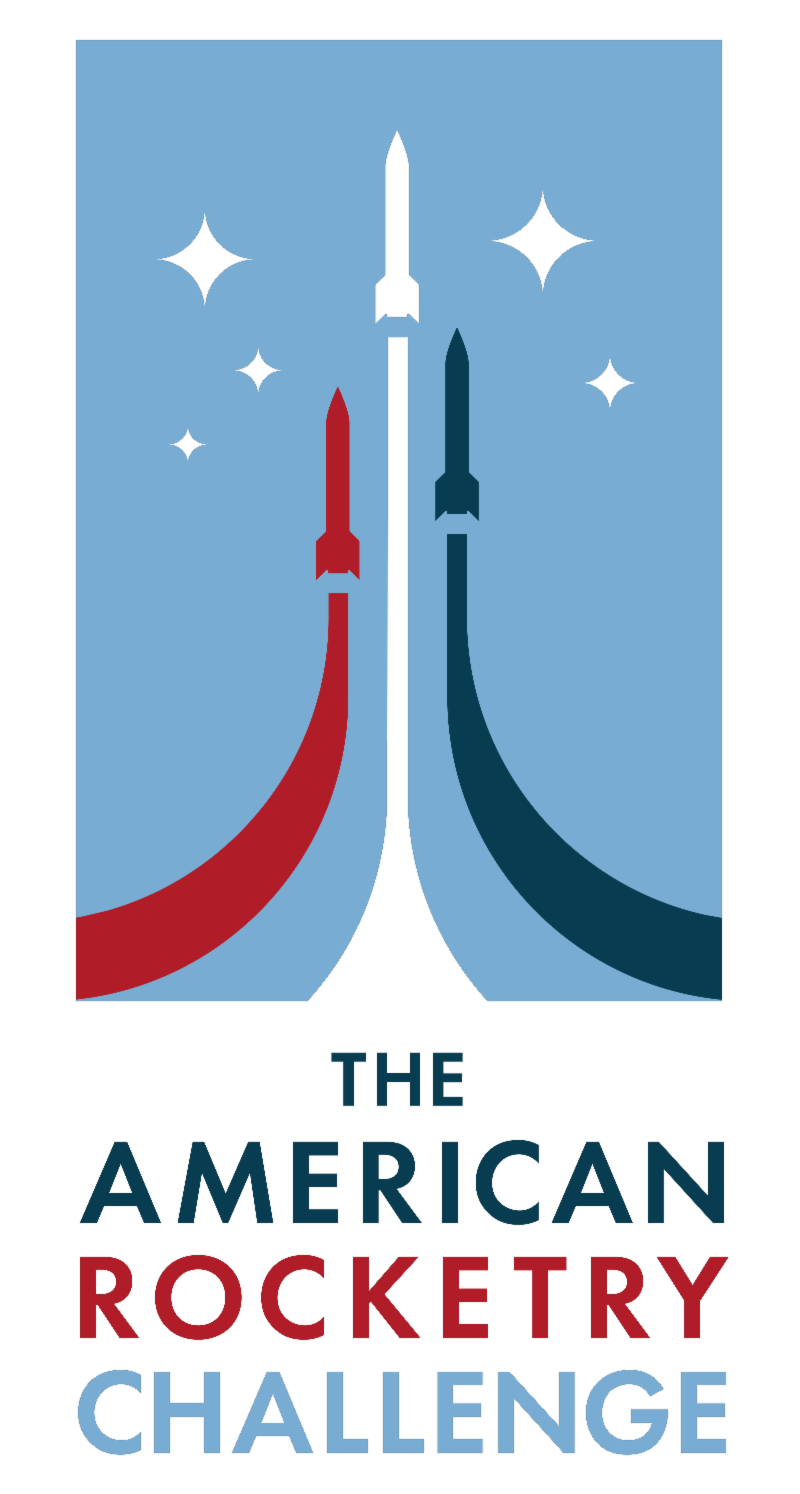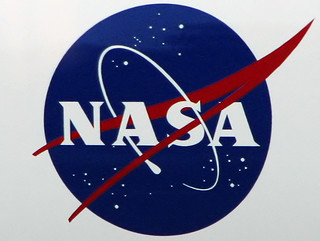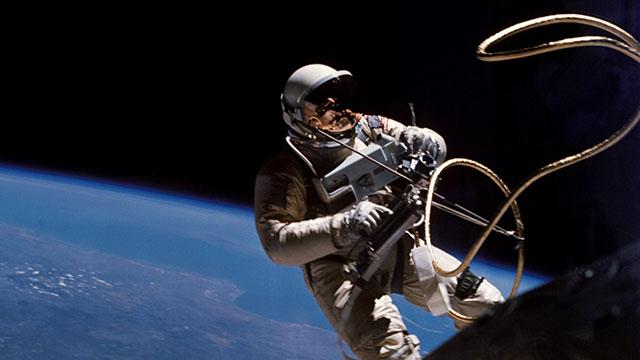| ~~~~~~~~~~~~~~~~~~~~~~~~~~~~~~~~~~~~~~~~~~~~~~~~
National Association of Rocketry
Educator's Newsletter
June 2019
~~~~~~~~~~~~~~~~~~~~~~~~~~~~~~~~~~~~~~~~~~~~~~~~ |

Remembering the Moon
You should be getting ready to celebrate the 50th anniversary of the Apollo 11 landing on the moon on
July 20, 2019.
If you're planning a commemorative launch of any kind you can register that launch to be counted in a global launch record attempt July 16, the day the Saturn V lifted off, by the Space and Rocket Center (Space Camp) in Huntsville, AL.
https://www.rocketcenter.com/apollo50/GlobalRocketLaunch. Here's a chance to have your
commemorative launches count for more than just a local celebration.
Besides launching a rocket or a scale model NAR is proposing that schools and clubs have a "land the eagle" contest where
the objective is to launch a model rocket and have it land on an area in a field representing the moon. The contestant whose rocket lands closest to the Tranquility Base target is the winner. Suggestions for hosting the event are at
http://www.nar.org/land-the-eagle-contest-for-schools/ .
This July will be immersed in moon landing celebrations, so don't miss this teachable moment for your summer program to show what was historically humanity's greatest STEM accomplishment.
Aim high!
Vince Huegele
NAR Education Chairman
|
|
 2019 The America Rocketry Challenge (TARC)
2019 The America Rocketry Challenge (TARC)
The TARC
http://www.rocketcontest.org/ is the world's largest rocket contest, sponsored by the Aerospace Industries Association (AIA) and the National Association of Rocketry in partnership with AAPT, DoD, NASA, and AIA member companies.
TARC 2019 Finals brought to a conclusion a great 17th year for the Team America Rocketry Challenge. 830 teams (with a total of over 5000 student members, the largest number since 2003) enrolled in the program, and 470 of these submitted qualification flight reports.
Congratulations to the team from Madison West High School of Madison, WI. Madison West w
ill be going to the Paris Air Show courtesy of Raytheon Company to fly against the winners of the TARC-like events in the UK, France, and Japan. And they collected $21,000 of the overall prize pool of $100,000 that was split across the top 10 teams
.
Thank you to 115-person NAR volunteer range crew and our AIA partners. Thanks as well to all the teachers, mentors, and parents who supported all the teams in TARC 2019 throughout the year. And congratulations to all the student teams who travelled to Great Meadow to fly!
The key elements of the rules for TARC 2020 are:
-
800 feet, 40 - 43 seconds for qualification flights
-
1 egg, any orientation
-
All parts must recover connected, using parachute
-
No specifications for body diameter or parachute size
-
Still have to be painted at the Finals, but no Saturn 5 resemblance event
-
FIRST flight at the Finals will be 25 feet higher or lower than 800 feet based on coin flip Friday night, SECOND flight will be the other - no flights at the Finals will have 800 feet as the goal. Durations adjusted by 1 sec tracking the altitude.
Again, thank you to all the parents, teachers, and NAR mentors and volunteers (you) who supported and taught the students in TARC 2019, and congratulations to all the students who competed in it! I look forward to continuing to work with you and with another amazing crop of young students in this rewarding NAR "paying forward" program in its upcoming 18th year.
Finally, "TARC" now stands for "The American Rocketry Challenge". It is being rebranded (without changing the acronym "TARC") to make it more attractive to students who are, or could be, interested in rocketry and aerospace and to allow us to better reflect the goals, accomplishments, and stories that have become an integral part of the competition. Its goal remains to create and inspire the next generation of the America aerospace workforce through safe model rocketry.
NAR 4322 L3
NAR TARC Manager
|
Interested in a Fellowship this Summer?
Industry Initiatives for Science and Math Education (IISME), founded in 1985, seeks to transform teaching and learning through industry-education partnerships. IISME exists to address the critical need for a strong, highly skilled workforce in math, science and technological fields. IISME recruits sponsors in California from Alameda, Contra Costa, Marin, Sacramento, San Francisco, San Mateo, Santa Clara, and Santa Cruz Counties. The majority of Fellowships are offered in the Palo Alto, Sunnyvale, Santa Clara and San Jose Area.
This industry-education partnership focuses on teachers as the primary agents for effecting meaningful change in mathematics and science education. IISME provides teachers with experiences and tools they need to adapt their practices and change their schools so that all students are prepared to be lifelong learners, responsible citizens and productive employees. http://www.igniteducation.org/
|
|
INSPIRING OTHERS
 US Space and Rocket Center US Space and Rocket Center
The first moon landing occurred on July 20, 1969, on the Apollo 11 mission. An estimated 530 million people watched Armstrong's televised image and heard his voice describe the event as he took "...one small step for a man, one giant leap for mankind."
Apollo 11 launched from Cape Kennedy on July 16, 1969, at 9:32 a.m. EDT, carrying Commander Neil Armstrong, Command Module Pilot Michael Collins and Lunar Module Pilot Edwin "Buzz" Aldrin on top of a Saturn V rocket. The Saturn V rocket was 111 meters (363 feet) tall, about the height of a 36-story-tall building. Fully fueled for liftoff, the Saturn V weighed 2.8 million kilograms (6.2 million pounds), the weight of about 400 elephants and generated 34.5 million newtons (7.6 million pounds) of thrust at launch, creating more power than 85 Hoover Dams. Huntsville, Alabama, also known as the "Rocket City," is home to NASA's Marshall Space Flight Center, where the Saturn V was developed.
The launch of Apollo 11 brought the world closer together in a moment of celebration for mankind's monumental achievement, and 50 years later, Huntsville and Space Camp want your help bringing the world together again to celebrate another awe-inspiring launch-YOUR launch! Join in the worldwide celebration of the 50th anniversary of the Apollo 11 launch on July 16, 2019 by launching your
own rocket! All types of rockets are welcome, and no launch is too small so start spreading the word and get ready to celebrate! Sign up today and get ready to countdown to July 16, 2019!
The North Carolina School of Science and Mathematics
The North Carolina School of Science and Math Summer Accelerator Program extends to a global audience our 30 years of experience offering innovative courses and opportunities to talented high school students.
The Accelerator program offers unique, high-level courses in an innovative format that incorporates both residential, hands-on learning and online education. This summer, explore aerospace engineering by designing and launching your own rocket. Analyze the connection between music and math and compose your own work in Music of the World and the Math Behind It. Uncover the secrets of the dead and real-world excavation methodology in Death and Burial Around the World.
Highly skilled faculty focus their talents on building upon the strengths of high-achieving students in advanced science and math topics in the classroom. Student Life Instructors offer a valuable resource and help provide a safe and enjoyable residential experience for students out of the classroom. NCSSM crafts unique college-level academic experiences, as a constituent and flagship high school of the University of North Carolina system, in a setting designed specifically for high school students.
Explore complex topics, collaborate with peers from around the globe, and get hands-on experience that will kick start college readiness and career interests this summer.
Innovation Now
How about a daily 90 second radio program that features highlights in aeronautics and aeronautics technology, science, history, innovations, research, and inventions from the aerospace industry? Try this one out!
www.innovationnow.us
 Civil Air Patrol Civil Air Patrol
Collectively, we can have a remarkable impact on a partnering national organization. Take the time to contact a
local Civil Air Patrol squadron near you and Pay Forward!
You can find a local squadron by entering your zip code or city and state in the online unit locator. Each of these squadrons would welcome your insights and camaraderie! Additionally, the Civil Air Patrol has an Advanced Rocketry Program (and Guide) for those folks who enjoy High Power Rocketry as well as Mid and Low Power...It's a great opportunity to share experiences and Pay Forward!
 4-H 4-H
The
Rocketry School Enrichment and After School Enrichment Program
helps students meet Pennsylvania Academic Standards in science. 4-H project books are available for
Delaware County, Pennsylvania
classroom teachers, home school families, and after school clubs to use with students.
Estes
Promote STEM with Reach For The Stars - National Rocket Competition
There is still time to get your kids into the Reach for the Stars - National Rocket Competition. The deadline for entering is August 31st, which gives museums, schools, scouts and youth groups enough time to get their supplies and run a local event. This year's Competition was kicked off by famed author Homer Hickam in Coalwood, West Virginia at the October Sky Festival - with the original "Rocket Boys" giving the countdown.
Special pricing makes the Competition very affordable. In most cases the cost of the rocket kit, supplies for two launches, achievement certificate and Competition registration is less than the list price of the rocket kit alone. A step-by-step video and on-line help, supplied free with order, are available to guide you. The Competition is for ages 10 to adult, with three levels determined by age. Time and supplies are limited, so get started now! More information is at TheRocketman.net.
|
| RESOURCES
 NASA Makes Finding Teaching Materials Easy NASA Makes Finding Teaching Materials Easy
NASA's Education Materials Finder will help you locate resources that can be used in the classroom. Users may search by keywords, grade level, product type and subject. With hundreds of publications and Web sites indexed, the finder is a great way to
locate NASA educational resources.
Rocketry School Supplies Provided by Donors
As teachers, you know your students' needs best.
Donorschoose.org is available to provide an avenue for public school teachers to submit project requests for the specific materials their students need to learn.
As their name implies, donors choose which projects to support. Once a project is funded, they deliver the materials directly to the school.
In return, teachers submit photos of the project in use and thank-you notes from students, which are then sent to the project's donors.
|
 National Association of Rocketry (NAR) Offers Teachers and Youth Group Leaders Resources
National Association of Rocketry (NAR) Offers Teachers and Youth Group Leaders Resources
Free resource downloads produced by members who have helped teachers and youth group leaders like yourself all over the United States.
|
|
Space History
 3 June 1965:
3 June 1965: Astronaut Edward H. White II became the first American to perform what in NASA parlance is referred to as an Extra Vehicular Activity (EVA). In everyday terms; a spacewalk.
White, Mission Commander James A. McDivitt and their Gemini IV spacecraft were launched into low Earth orbit by a two-stage Titan II launch vehicle from LC-19 at Cape Canaveral Air Force Station, Florida. The mission clock started at 15:15:59 UTC on Thursday, 03 June 1965.
On the third orbit, less than five hours after launch, White opened the Gemini IV starboard hatch. He stood in his seat and mounted a camera to capture his historic space stroll. He then cast-off from Gemini IV and became a human satellite.
White was tethered to Gemini IV via a 15-foot umbilical providing oxygen and communications to his EVA suit. A gold-plated visor on his helmet protected his eyes from the searing glare of the sun. The space-walking astronaut was also outfitted with a hand-held maneuvering unit using compressed oxygen to power its small thrusters. And, like any good tourist, he also took along a camera. He
had the time of his all-too-brief life in the 22 minutes he walked in space. The sight of the earth, the spacecraft, the sun, the vastness of space, the freedom of movement all combined to make him exclaim at one point, "I feel like a million dollars!".
Presently, it was time to get back into the spacecraft. But, couldn't he just stay outside a little longer? NASA Mission Control and Commander McDivitt were firm. It was time to get back in; now! He grudgingly complied with the request/order, plaintively saying: "It's the saddest moment of my life!"
As Ed White got back into his seat, he and McDivitt struggled to lock the starboard hatch. Both men were exhausted, but ebullient as they mused about the successful completion of America's first spacewalk.
Gemini IV would eventually orbit the Earth 62 times before splashing-down in the Atlantic Ocean at 17:12:11 GMT on Sunday, 07 June 1965. The 4-day mission was another milestone in America's quest for the moon.
The mission was over and yet Ed White was still a little tired. But this was really quite easy to understand. In the time he was working outside the spacecraft, Gemini IV had traveled almost a third of the way around the Earth...
Now, that's a long walk!
 18 June 1983: Sally Kristen Ride became the first American woman to go into space when she flew on the space shuttle Challenger (STS-7) as a mission specialist, NASA's seventh shuttle mission. The mission returned to Earth on June 24. Tasks on the mission included launching communications satellites for Canada and Indonesia. The astronauts also conducted the first successful satellite deployment and retrieval in space using the shuttle's robotic arm. During the flight, Ride became the first woman to operate the shuttle's robotic arm. 18 June 1983: Sally Kristen Ride became the first American woman to go into space when she flew on the space shuttle Challenger (STS-7) as a mission specialist, NASA's seventh shuttle mission. The mission returned to Earth on June 24. Tasks on the mission included launching communications satellites for Canada and Indonesia. The astronauts also conducted the first successful satellite deployment and retrieval in space using the shuttle's robotic arm. During the flight, Ride became the first woman to operate the shuttle's robotic arm.
Ride's history-making Challenger mission was not her only spaceflight. She also became the first American woman to travel to space a second time when she launched on another Challenger mission, STS-41-G, on Oct. 5, 1984. The mission lasted nine days. On this flight, she used the shuttle's robotic arm to remove ice from the shuttle's exterior and to readjust a radar antenna. Ride was assigned to a third shuttle mission, but her crew's training was cut short by the Challenger disaster in January 1986.
Ride died of cancer in 2012.
 30 June 2004:
It took seven years for Cassini to make the trip from Earth's surface to Saturn's orbit. The two-story-tall spacecraft reached Saturn on June 30, 2004, to begin unprecedented surveys of the planet and its brilliant rings, along with Saturn's eclectic system of moons. As the mission came to a close, NASA opted to plunge the spacecraft into Saturn to prevent it from accidentally contaminating one of the moons if it were left to drift around in space. 30 June 2004:
It took seven years for Cassini to make the trip from Earth's surface to Saturn's orbit. The two-story-tall spacecraft reached Saturn on June 30, 2004, to begin unprecedented surveys of the planet and its brilliant rings, along with Saturn's eclectic system of moons. As the mission came to a close, NASA opted to plunge the spacecraft into Saturn to prevent it from accidentally contaminating one of the moons if it were left to drift around in space.
Cassini also carried a second spacecraft along with it, a probe called Huygens, released to study the moon Titan up close. Huygens parachuted to the surface of the moon, relaying data on conditions there until its batteries ran out.
Cassini, built and operated from the Jet Propulsion Laboratory in Pasadena, California, lifted off from Cape Canaveral, Florida, in 1997 atop a Titan IVB rocket. The launch capped months of processing on the spacecraft and booster to make sure everything would work correctly on launch day and Cassini would be set on its correct path.
The Titan IVB rocket was NASA's largest expendable booster at the time.
Despite the size of the rocket, Cassini would still take seven years to reach Saturn. It would fly a precise path through the inner solar system building up speed by passing near Venus and Earth so it could slingshot out beyond Mars and Jupiter to rendezvous with Saturn. Getting on this path correctly at the start was the focus of the launch team...
The payoff was a wealth of photos and data of one of the solar system's most captivating locations!
|
|
| |
 Quick Links... Quick Links...
~~~~~~~~~~~~~~~~~~~~~~~~~~~~~~~~~~~~~~~~~~~~~~~~
|
|
| |
|